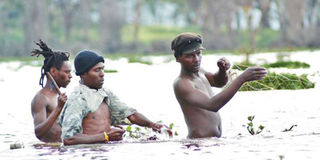Outrage over authority’s plan to reduce L. Naivasha riparian land

Fishermen in Lake Naivasha. FILE PHOTO | NATION MEDIA GROUP.
What you need to know:
Stakeholders say move would negatively affect fishing sector and worsen human-wildlife conflict.
- Lake Naivasha is home to some of the world’s rare birds, other wildlife and plants.
On the wooded shorelines of Lake Naivasha, a couple of fishermen are landing their catch for the day. Behind them, in the waters, several boats are swaying under the weight of shoals of common carp fish and salmon as they sail ashore.
It is a pretty good day reckon the fishermen, except that the joy won’t last long since the fishing bay could soon be gone.
WORLD HERITAGE
“A few weeks ago, the Water Resource Authority ran an advert in a local newspaper, announcing its plans to reduce the lake’s riparian land,” said Mr Kennedy Waweru, a local fisherman. “The announcement is really troubling our hearts.”
On October 23, the Water Resource Authority (WRA) published a proposal to review the riparian boundary of Lake Naivasha from 1,892.8 metres above sea level to 1,888 metres.
Local fishermen, fish traders, boat and hotel owners and members of the Lake Naivasha Riparian Association are, however, strongly opposed to the move, saying that it will not only worsen the human and hippo conflicts, but will also adversely affect the fishing industry and destroy the lake’s biodiversity, which is crucial for tourism.
Covering over 140 square kilometres, Lake Naivasha — which derives its name from the local Maasai word Nai'posha meaning ‘receding waters’ — is a Ramsar world heritage site and home to some of the world’s rare birds, other wildlife and plants.
African fish eagle — one of the continent’s most loved birds, known for its graceful aerial skills and distinctive plumage — is among the birds that not only nest in the woodlands around the lake, but are major tourist attractions.
WATER POLLUTION
Lake Naivasha Riparian Association manager Silas Wanjala explained that riparian lands around any water body protect it from pollution.
He said the papyrus fringe around the lake purifies the water, noting that bringing the boundary closer to the reeds will expose the habitat and pollute the lake.
“The riparian areas are habitats for birds and hippos. The hippos have no other place to go other than the riparian areas. Interfering with their habitats will exacerbate hippo attacks,” he warned.
Mr Wanjala said the hived-off pieces of land — estimated to be over 100,000 acres — would be surrendered to the National Land Commission and could be redistributed to influential individuals.
“If that happens the lake will be reduced to a water reservoir rather than an ecosystem as we know it,” he cautioned.
Ruth, whose husband was attacked and killed by a hippo last year during a fishing expedition, is also against WRA’s plan.
FISH BREEDING
The mother of four, who became a fishmonger to fend for the family, said her husband was bitten by a hippo on the leg in December last year while casting his nets along the shores. He succumbed to his injuries the following day.
“Sadly, we have never received any compensation from Kenya Wildlife Services,” she said.
Mr David Kilo, a boat owner and the chairman of Lake Naivasha Boat Owners Association, said the shrinking riparian land would affect the fish breeding grounds and the movement of herbivores such as waterbucks, buffaloes and the giraffes. “We do not understand why WRA is keen to grab parts of the lake’s riparian land. Who does it want to allocate the land to?” Mr Kilo asked.
Ms Rachel Wangui, a fish trader, added: “Fencing will only leave a small section of land for fish landing, traders, restaurants and tourists, which will increase the human-wildlife conflict.”





